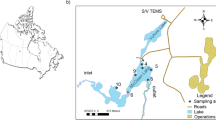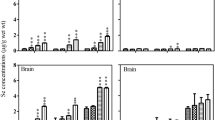Abstract
The increased flux of selenium into aquatic ecosystems due to anthropogenic activities has resulted in the degradation of several systems. Initial experiments examined the comparative acute toxicity of waterborne selenate, selenite, and seleno-DL-methionine to fourth instar Chironomus decorus larvae resulting in 48-h LC50 concentrations of 23.7, 48.2, and 194 mg Se/L, respectively. The relative toxicities of the selenium forms are reversed compared to previous studies on other species and demonstrate that relative waterborne selenium toxicity is species specific. Studies examining the kinetics of selenate and selenite (the dominant waterborne forms) accumulation by C. decorus larvae exposed to the 48-h LC50 selenium concentrations showed initial rapid uptake and subsequent plateauing with maximum concentrations attained by 16 h. The final whole body selenium levels were approximately 63 mg Se/kg for selenate and 85 mg Se/kg for selenite. Comparative bioconcentration experiments demonstrated that after 48 h selenium accumulation was greater in larval C. decorus exposed to 25 mg Se/L as seleno-DL-methionine than in those exposed to 25 mg Se/L as selenate and selenite.
Similar content being viewed by others
References
American Public Health Association (APHA) (1985) Standard Methods for the Examination of Water and Wastewater. American Public Health Association, Washington, DC
Bem EM (1981) Determination of selenium in the environment and in biological material. Environ Health Perspect 37:183–200
Birkner JH (1978) Selenium in aquatic organisms from seleniferous habitats. PhD dissertation, Colorado State University, Fort Collins, CO
Bottino NR, Banks CH, Irgolick KJ, Micks P, Wheeler AE, Zingaro RA (1984) Selenium-containing amino acids and proteins in marine algae. Phytochemistry 23:2445–2452
Brooke LT, Call DJ, Harting SL, Lindberg CA, Markee TP, McCauley DJ, Poirier SH (1985) Acute toxicity of selenium (IV) and selenium (VI) to freshwater organisms. Center for Lake Superior Environmental Studies, University of Wisconsin, Superior
Call DJ, Brooke LT, Ahmad N, Richter JE (1983) Toxicity and metabolism studies with EPA (Environmental Protection Agency) priority pollutants and related chemical in freshwater organisms. Available NTIS, PB83-263665 or EPA-600/3-83-095, US Environmental Protection Agency, Washington, DC
Connell DW, Miller GJ (1984) Chemistry and ecotoxicology of pollution. John Wiley & Sons, NY
Cooke TD, Bruland KW (1987) Aquatic chemistry of selenium: Evidence of biomethylation. Environ Sci Technol 21:2114–2119
Copeland RA (1971) Selenium: The unknown pollutant. Limnos 3:7–9
Cumbie PM, Van Horn SL (1978) Selenium accumulation associated with fish mortality and reproductive failure. Proc Annu Conf Southeast Assoc Fish Wildlife Agencies 32:612–624
Eisler R (1985) Selenium hazards to fish, wildlife and invertebrates: A synoptic review. US Fish and Wildl Serv Biol Rept 85(1.5). US Fish and Wildl Serv, Dept of the Interior, Washington, DC
Frost DV, Lish PM (1975) Selenium in Biology. Annu Rev Pharmacol 15:259–284
Gillespie R, Baumann P (1986) Effects of high tissue concentrations of selenium on reproduction by bluegills. Trans Am Fish Soc 115:208–213
Ingersoll CG, Dwyer FJ, May TW (1990) Toxicity of inorganic and organic selenium to Daphnia magna (Cladocera) and Chironomus riparius (Diptera). Environ Contam Toxicol 9:1171–1181
Kiffney P, Knight AW (1990) The toxicity and bioconcentration of selenate, selenite and selenomethionine by the alga Anabaena flos-aquae. Arch Environ Contam Toxicol 19:488–494
Lemly AD (1985) Toxicology of selenium in a freshwater reservoir: Implications for environmental hazard evaluation and safety. Ecotox Environ Safety 10:314–338
Maier KJ, Foe CG, Knight AW (1993) Comparative Toxicity of Selenate, Selenite, Seleno-DL-methionine and Seleno-DL-cystine to Daphnia magna. Environ Toxicol Chem 12:755–763
Maier KJ (1990) The bioaccumulation and toxicity of selenium and boron to the freshwater invertebrates. Daphnia magna and Chironomus decorus. PhD dissertation, University of California, Davis, CA
Maier KJ, Kosalwat AW, Knight AW (1990) Culture of the midge Chironomus decorus (Diptera: Chironomidae) and the effect of temperature on its life history. Environ Ent 19:1681–1688
Maier KJ, Ogle RS, Knight AW (1988) The selenium problem in lentic ecosystems. Lake and Res Mgt 4:155–163
Mayer FL, Ellersieck MR (1986) Manual of acute toxicity: Interpretation and data base for 410 chemicals and 66 species of freshwater animals. United States Department of the Interior, Fish and Wildlife Service, Resource Publication 160, Washington, DC
Moore SB, Detwiler SJ, Winkel J, Weegar MD (1989) Biological residue data for evaporation ponds in the San Joaquin Valley of California. San Joaquin Valley Drainage Program, Sacramento, CA
Nassos PA, Coats JR, Metcalf RL, Brown DD, Hansen LG (1980) Model ecosystem toxicity and uptake evaluation of 75Se-selenium. Bull Environ Contam Toxicol 24:752–758
National Academy of Sciences (1976) Hemphill DD (ed) Selenium: Medical and biological effects of environmental pollutants. Div Med Sci Natl Acad Sci, Washington, DC
Niimi AJ, LaHam QN (1976) Relative toxicity of organic and inorganic compounds of selenium to newly hatched Zebrafish (Brachydanio rerio). Can J Zool 54:501–509
Ogle RS, Maier KJ, Kiffney P, Williams MJ, Brasher A, Melton LA, Knight AW (1988) Bioaccumulation of selenium in aquatic ecosystems. Lake Res Mgt 4:155–163
Ohlendorf HM (1988) Bioaccumulation and effects of selenium in wildlife. In: Selenium in agriculture and the environment. Soil Sci Soc Am Spec Publ No 23. Soil Sci Soc Am and Am Soc Agron, Madison, WI
Ohlendorf HM, Hoffman DJ, Saiki NK, Aldrich TW (1986) Embryonic mortality and abnormalities of aquatic birds: Apparent impacts of selenium from irrigation drain water. Sci Total Environ 52:49–63
Robberecht H, Van Grieken R (1982) Selenium in environmental waters: Determination, speciation and concentration levels. Talanta 29:823–844
Saiki MK, Lowe TP (1987) Selenium in aquatic organisms from subsurface agricultural drainage water, San Joaquin Valley, California. Arch Environ Contam Toxicol 16:657–670
SAS Inc (1985) SAS user's guide: statistics, version 5. SAS Institute Inc, Cary, NC
Schuler CA (1987) Impacts of Agricultural Drainwater and Contaminants on Wetlands at Kesterson Reservoir, California. M.S. thesis., Oregon State University, Corvallis, OR
Sorensen EM, Baver BTL, Bell JS, Harlan CW (1982) Selenium accumulation and cytotoxicity in Teleosts following chronic environmental exposure. Bull Environ Contam Toxicol 29:688–697
Takayanagi K, Wong GTF (1985) Dissolved inorganic and organic selenium in the Orca Basin. Geochim. Cosmochim Acta 49:539–546
US Environmental Protection Agency (USEPA) (1975) Methods for acute toxicity tests with fish, macroinvertebrates and amphibians. EPA-660/3-75-009. Corvallis, OR
Weiss KF, Ayres JC, Kraft AA (1965) Inhibitory action of selenite on Escherichia coli, Proteus vulgaris and Salmonella thompson. J Bacteriol 90:857–862
Wrench JJ (1978) Selenium metabolism in the marine phytoplankton, Tetraselmis tetrathele and Dunaliella minuta. Mar Biol 49:231–236
Author information
Authors and Affiliations
Rights and permissions
About this article
Cite this article
Maier, K.J., Knight, A.W. Comparative acute toxicity and bioconcentration of selenium by the midge Chironomus decorus exposed to selenate, selenite, and seleno-DL-methionine. Arch. Environ. Contam. Toxicol. 25, 365–370 (1993). https://doi.org/10.1007/BF00210728
Received:
Revised:
Issue Date:
DOI: https://doi.org/10.1007/BF00210728




